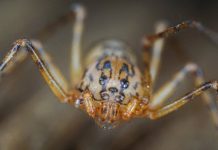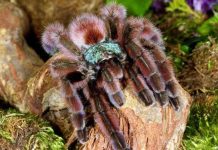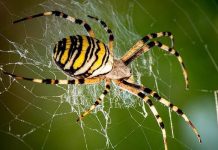The Mexican Red-Knee Tarantula is one of the most popular captive bred spider species due to its large size and bright coloration. Due to a sharp decline in the number of Mexican Red-Knee Tarantulas, under the CITES agreement, this species was included in the list prohibited for trapping for the purpose of selling animals, and a ban was introduced on the import or export of any spiders of the genus Brachypelma.
Mexican Red-Knee Tarantula Appearance and Temperament
The Mexican Red-Knee tarantula is popular for its bright coloration and large size. From the very name of the spider, one can single out the most distinctive and memorable feature of its appearance – red-knee. The Tarantula has a dark brown, close-to-black body color. On his paws, in the area of connection, shades of red or orange with yellow or white framing. After each molt, the color of the spider becomes more expressive and contrasting. Its body is covered with thick hairs of light pink or brown color. Under stress, the Tarantula throws off hairs from the abdomen. If the hair gets on the human skin, irritation and redness may appear, and if the hair gets into the eyeball, it may impair vision. Mexican Red-Knee Tarantula has the following physique: a fat abdomen, an extensive cephalothorax, massive paws. The multi-colored, reminiscent of a decorated Christmas tree, color awakens in a person, not disgust and fear of the spider, but the desire to acquire it. The white ends of the hairs give the Tarantula a special look of softness. The body length of the Tarantula reaches 7-8 cm, and the size of the paws is 17 cm. There is a difference between the male and the female: the females are somewhat larger.
After each molt, the color of the spider becomes more expressive and contrasting. Its body is covered with thick hairs of light pink or brown color. Under stress, the Tarantula throws off hairs from the abdomen. If the hair gets on the human skin, irritation and redness may appear, and if the hair gets into the eyeball, it may impair vision. Mexican Red-Knee Tarantula has the following physique: a fat abdomen, an extensive cephalothorax, massive paws. The multi-colored, reminiscent of a decorated Christmas tree, color awakens in a person, not disgust and fear of the spider, but the desire to acquire it. The white ends of the hairs give the Tarantula a special look of softness. The body length of the Tarantula reaches 7-8 cm, and the size of the paws is 17 cm. There is a difference between the male and the female: the females are somewhat larger.
The Mexican Red-Knee Tarantula is active at night. In the daytime, the Tarantula prefers to hide under stones or in dug holes to escape the heat, because they live in places with a dry climate. During the molt, Mexican Red-Knee Tarantula arranges an extraordinary and unforgettable sight: the spider pleases the eye by mixing shades of red with black or yellow and black. With each subsequent molt, the Tarantula’s color becomes more expressive: dark shades become almost black, and areas with a red tint increase the degree of red. On average, the gap between molts is about two months.
The Mexican Red-Knee Tarantula is a non-hostile and calm species of spider. However, the protective hairs located on the abdomen can be used by the Tarantula as a defense. Bite incidents or attempted bites are rare. Spider venom does not pose a particular threat to human life. Despite this, the risk of consequences contributing to the occurrence of fatal allergies cannot be ignored.
Spiders do not react with hostility to cleaning in the terrarium, but patiently and calmly waits for it. This helps to reduce the risk of being bitten at this point.
The Mexican Red-Knee Tarantula holds the record for spider lifespan. The male can live for about 6 years, and the females up to 20. However, there are cases when they live more than 20 years. This is an impressive period because 20 years is much longer than the life of other pets.
Habitats of the Mexican Red-Knee Tarantula
Representatives of the Red-Knee Tarantula spiders are found in areas of Mexico off the Pacific Ocean, as well as in some southern regions of the United States. The preferred habitats for arthropods are areas with high humidity and high air temperatures. Individuals like to hide among bushes, so they choose areas with abundant vegetation. Unfortunately, at present, due to the capture of animals, their number has sharply decreased. Under the CITES agreement, the species was included in the list of animals prohibited from capture for sale.
Housing the Mexican Red-Knee Tarantula
Tarantulas are easy to breed in captivity. It is important to keep them one at a time in the terrarium, as these spiders are cannibalistic. Tarantulas prefer bark, coconut substrate, and the like of a tree, such as driftwood, in the terrarium. It is important to create a semblance of a mink, for this a cup, coconut shell, or any other container will do. Do not forget that spiders move well on any planes, so his dwelling should be covered with a lid.
Since the Mexican Red-Knee Tarantula is terrestrial, a horizontal type of terrarium would be ideal for it; for an adult, a standard terrarium 30x30x30 centimeters is suitable. Maintain humidity at 65-75%, this can be achieved by moistening 1/3 or a little more of the substrate, it is best to water it from a syringe or something similar, for an adult Mexican Red-Knee Tarantula, be sure to install a drinking bowl with clean water. The temperature, as well as for many Brachypelm, is standard: 24-28 degrees Celsius.
Food
Tarantula Spiders have external digestion. This means that the Tarantula Spider, having caught its prey and immobilizing it, introduces its digestive juice into it. After a while, he returns and sucks the contents of his prey. The whole process can sometimes take more than 24 hours. For the most part, the Mexican Red-Knee Tarantula feeds on live insects, which are small in size, this saves it from a possible fight with the prey. The largest representatives can feed on small vertebrates – naked mice. They can also be fed with cuts of meat, but not fatty ones. It should be added that the diet of an adult Tarantula Spider can include adult crickets, grasshoppers, large species of cockroaches.
The Tarantula Spider at the age of 1 to 3 days can feed on newborn mealworms, juveniles: crickets, the fruit fly. When choosing food for your Tarantula, it should be borne in mind that food insects should be no more than 1/4 or 1/3 in relation to the size of the spider’s body. Larger food can make the digestion process more difficult. Small insects can be given 2-3 at a time, the Tarantula can eat them right away.
If you have a young and often shedding Mexican Red-Knee Tarantula, then you need to feed it 2 times a week, adults should be fed once every 7-10 days. The frequency of feeding should be increased before breeding begins. Remember to tidy up the food that has not been eaten, whether it is alive or dead. A well-fed Tarantula Spider can get stressed from too much activity, such as a surviving cricket. In addition, during the molting period, the not sufficiently strengthened spider covers are not protected, and a large insect can damage them. Do not be alarmed if your Tarantula Spider suddenly refuses food. This may indicate the onset of molt, a low temperature in the enclosure, or an overflowing stomach.
Common Health Problems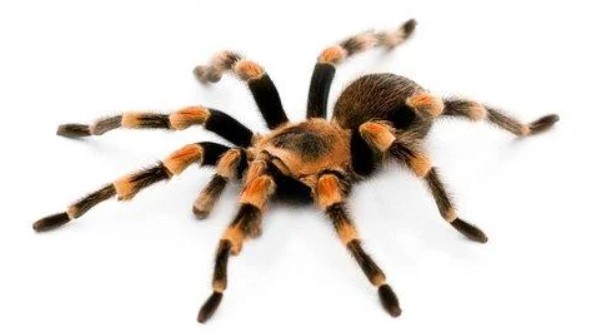
Like most spiders, Mexican Red-Knee Tarantulas rarely get sick. The most likely health problems can be caused by the following:
- Falling from a height – the spider’s exoskeleton is similar in structure to an eggshell, so a fall leads to its split and further death of the pet. You can avoid the problem if you use a soft substrate, and do not make too high structures in the spider.
- Dehydration – Mexican Red-Knee Tarantulas require higher humidity than other Tarantulas. Make sure that there is always moist soil and there is a drinking bowl with water. Spiders do not drink water, but the drinking bowl maintains the moisture level and they can sometimes bathe in it. The spider shows signs of dehydration, a slightly wrinkled abdomen, and very low activity. With severe dehydration, he can bend his paws under him. If you see these symptoms, move the spider to a separate container in which there is a damp towel, after a while, it will come to life. Do not put him in a container of water, he may drown, as his lungs are located in the lower body.
- Molting – Do not touch the spider during molting, even if it is lying upside down. This condition is normal for this process. But any attempt to touch it can lead to damage to the new fragile exoskeleton and the subsequent death of the pet.
Reproduction
Due to the fact that the spider grows slowly, males reach gender development closer to three years, and females – by five. The male and female Tarantulas must be kept in different terrariums. Having fed well, the male is placed next to the female. Here you should pay attention to the behavior of the female, which is associated with her aggressiveness towards the male. If dislike is observed, it is necessary to plant the male so that the female does not eat him.
For breeding, it is best to choose the winter period. Cool time with a temperature of 15-20 ° C and a decrease in humidity to 40-50%. For weaving a cocoon, it is better to increase the temperature to 28 ° C. A few days/weeks after the mating process, the female tarantula weaves a web and a cocoon, inside which there are eggs. After 90 days, spiders appear. From one cocoon, as a rule, from 500 to 1 thousand spiders hatch.
Conclusion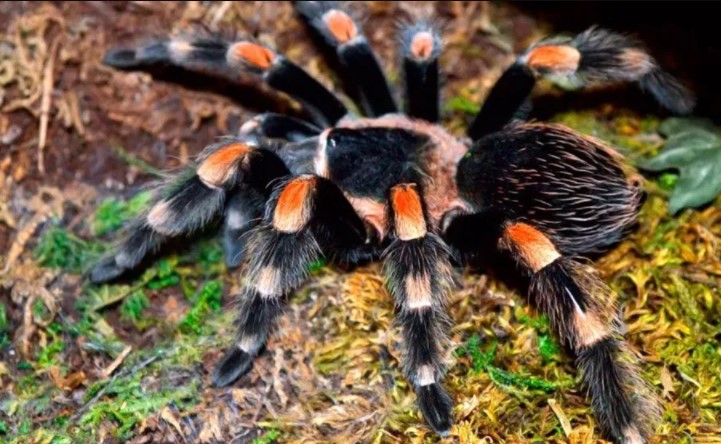
Mexican Red-Knee Tarantula is a great choice for all spider lovers. It is unpretentious in content, harmless to others, and has an attractive appearance.
Advantages:
- The relative ease of keeping. The spider does not require increased attention to itself, like any other pet.
- Cheapness. Spider feeding occurs infrequently, and the price of the individual itself is low due to its prevalence.
- Interesting molting and hunting processes.
Disadvantages:
- The only drawback is the fact that the spider cannot become such a family member as cats or dogs are, due to its small size.
If you want to get yourself a spider as a pet, but you still have no experience in keeping them, then you will not find a better peace-loving and calm spider. Everyone can buy a Tarantula of this species since the cost for them is very low.
===================================================
https://buzzsharer.com/2021/03/27/poecilotheria-metallica-species-profile/










